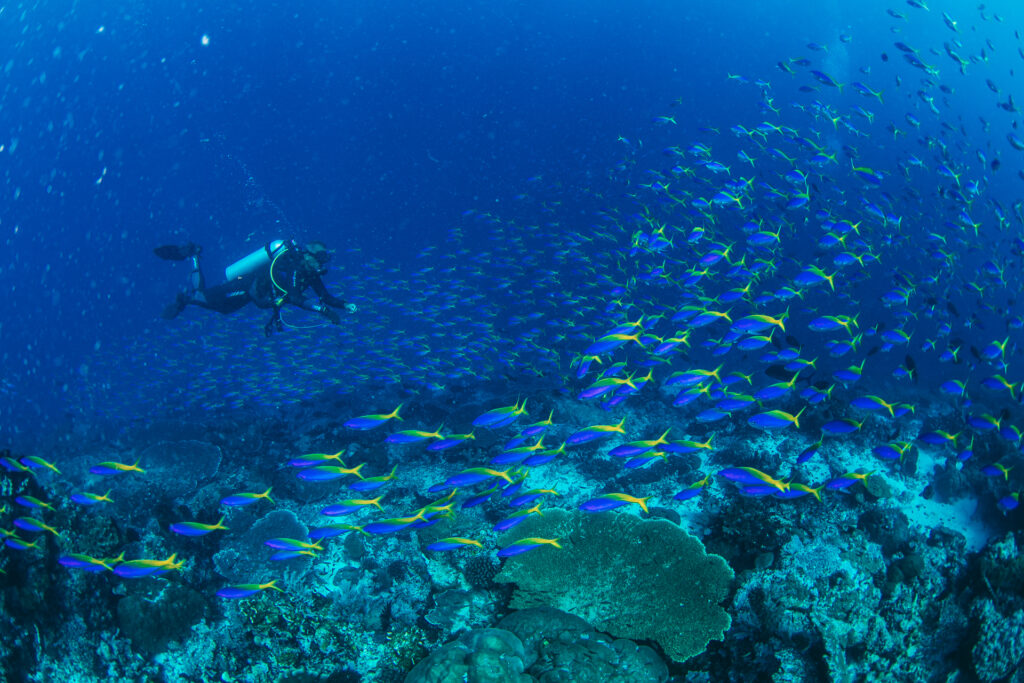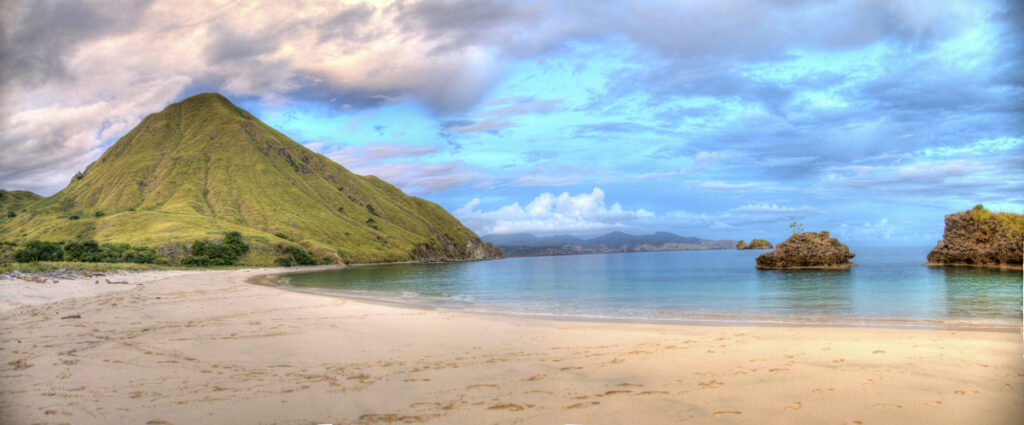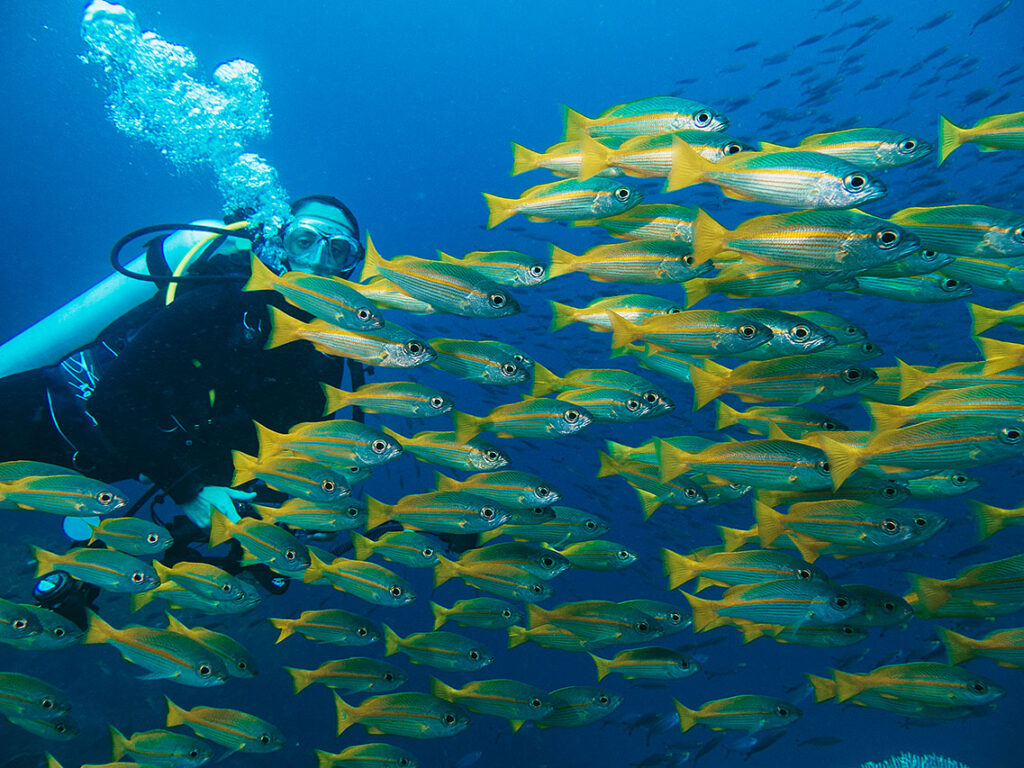THE SEVEN SEAS
KOMODO DEEP SOUTH
Dive Komodo like you have never done it before!
THE SEVEN SEAS
KOMODO DEEP SOUTH
Dive Komodo like you have never done it before!
Dive when the south at its best
Diving the Southern sites of Komodo National Park, and surrounding islands, has always been very exciting and unusual. Rocky canyons and pinnacles are heavily encrusted with marine invertebrate life, with lots of color and fish. Night diving, without a doubt, is one of the highlights here; lots of critters, and far superior to any of the sites in the north.
The only problem, during the “traditional” Komodo season from May through September, was that most of the time, the water was cold and murky, and when you got back to the boat, your towel had been blown off the deck by the South easterlies.
But, we will now show you the south side as you have never seen it before, and during the time that you should be there, during the Northwest Monsoon!


From October to May, this is the time of the year when it’s all different when the South is the Best! During the Northwest season, everything gets turned around and upside down in Komodo. The waters in the South are clear and warm, and a new underwater world opens up with many of our favorite sites now accessible, in the right conditions, and with new sites waiting to be explored!
This is why we will stay in Komodo when the South is Best while the rest of the fleet heads for Raja Ampat. This will not be the first time we do this, as we have done it many times in the past, by ourselves and with guests, starting when we operated the Evening Star in the Komodo area all year round from 1997 till 2002 and while we monitored all the sites around Komodo National Park, with The Nature Conservancy during the same years. So we know what we’re doing here!










Many people don’t know that during the North West Monsoon, between October and May, The south side of the island group completely changed. Conditions in the south improve dramatically as crystal clear currents move into the southern regions of the park.
While the prevailing wind moves from the southeast to the northwest, the Southern swell calms and the cold and murky southern upwelling ceases.
This gives us an excellent opportunity to focus on a wide variety of southern sites that would hardly be accessible during the other months of the year.
During our Deep South voyages, we will visit all our currently known high-class sites down South. Still, on top of that, you’re invited to join in the further exploration of new and promising areas that have already produced mind-blowing dives for us over the years.
We will visit all the well-known world-class sites such as Manta Alley, Cannibal Rock, Torpedo Point, The Three Sisters, Lankoi, etc. – plus many new and exciting sites all across the Southern territory and halfway up into the straits (such as Rainbow Reef, Indihiang Island, Batu Tiga and the mantas at Karang Makassar which aggregate there during this time of year).
We will not be surrounded by many other boats on these cruises, which is probably as important to us as it is for you.





Watch the Exploration
Komodo - Sumbawa May 2024
The Seven Seas Liveaboard 426 views
Wetpixel South Komodo Expedition 2014
The Seven Seas Liveaboard 171 views
Dive Deep South Komodo with the Seven Seas
The Seven Seas Liveaboard 874 views
Oceanic Manta, Deep South Komodo
The Seven Seas Liveaboard 61 views
Komodo Island Manta Ray Cleaning Station
The Seven Seas Liveaboard 354 views





Our itineraries in the Deep South of Komodo are exploring the Southern Sape Strait and all around South Komodo, South Rinca, South West Flores, Gili Mota and the Southern part of Selat Molo, and without a doubt, it is some of the world’s most unusual tropical diving.
We have discovered some very pristine and never visited world class sites in this area and are looking forward to continue the exploration of the south side with you in the next couple of years. Come and see the South as you’ve never seen it before!
The right conditions await us on our new itineraries down South. This is where we have filmed everything from the largest living animal in the world, the elusive Blue Whale, all the way down the food chain, via great fish life and vibrantly colored reefs created by orange and green cup corals, to soft coral heavens and the most unusual critters hidden in the black sand of volcanic islands that continue to re-create Indonesia’s Ring of fire.





Flights:
- Bali to Labuan Bajo on the mainland of Flores (daily), and
- Bali to Bima in Sumbawa at the other side of the Park (daily).
Attractive alternatives:
Board The Seven Seas in Benoa Harbour, Bali, and sail to Komodo National Park in 5 days. You get to enjoy the beautiful landscape of Lombok, Sumbawa and Sangean Volcano. Delight in some excellent dives on the way and don’t forget to catch a tuna at Sangean! This cruise is also offered in reverse direction, from Komodo to Bali. Contact us for more information.
- Superb for diving and snorkeling
- Hikes of 45 mins to 2.5 hrs to see the Komodo dragons, wild deer, horses and buffaloes
- Deserted beaches and surrounding hills are ideal for your sunset drinks on the beach
- Bays where the boat will anchor are perfect for afternoon water-skiing
- Slow tours with one of the tenders or kayaks to explore the coastline from the water
- Fishing is allowed in the pelagic fishing zone and outside the National Park
- Near Sangean Island, troll for tuna, Spanish mackerel, sail fish and giant trevally
| Southeast Monsoon Season: | May through October |
| North West Monsoon Season: | December through March |
| Change-over Months: | April and November |
| Air temperature: | 27 – 32°C |
| Water temperature: | Generally ranging from 24 to 30°C. Warmest in the North and coolest in the South during the Southeast Monsoon season while patterns are reversed during the North West Monsoon season. |
| Best time to dive: | Year Round with best diving in the North during South East Monsoon and best diving in the South during North West Monsoon. |
| Other interesting info: | Dive conditions vary with the tides, throughout the day. Therefore it is important to dive with the tide tables to hit every site at the optimal time. This is where your Seven Seas crew and dive guides excel! |
Southern waters: Generally provide better visibility from December through April. Lower visibility in the dry season – in the south – is due to oceanic up-welling and plankton richness, which makes this area very rich in marine life, especially invertebrates. An underwater photographers dream! Highest temperatures in the south are during the rainy season. Click here for our Deep South Komodo cruises.
Northern waters: Generally provide better visibility year round. Water temperature is usually higher. Fish are abundant everywhere but the rocks and reefs in ‘current’ areas provide the best chances for spotting the bigger fish, especially the sharks and pelagics.

